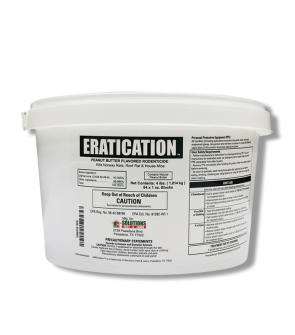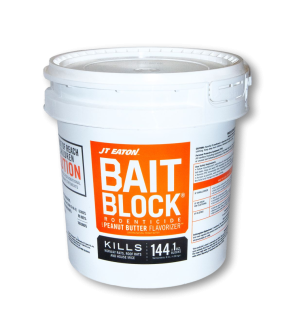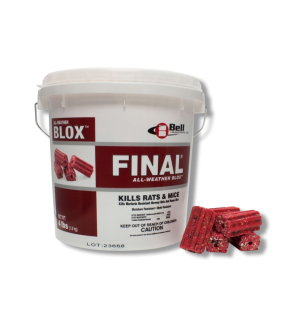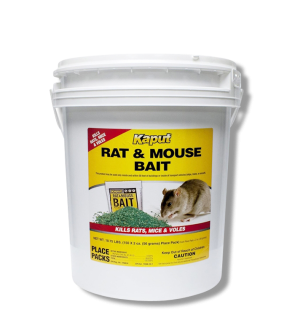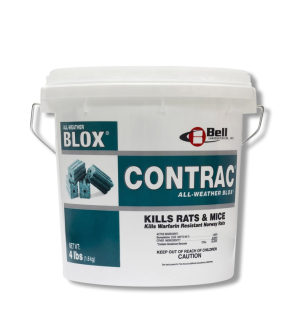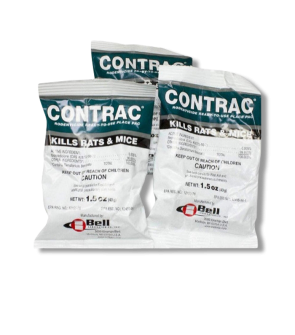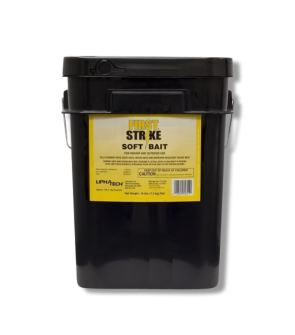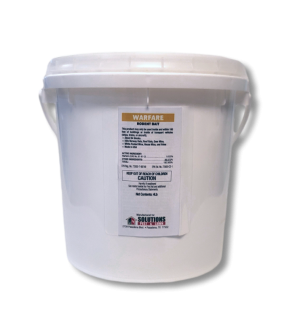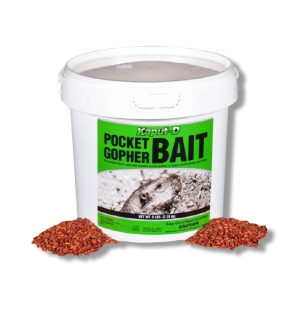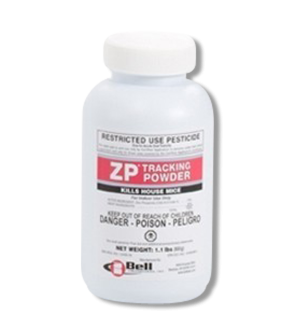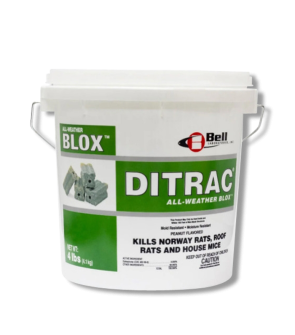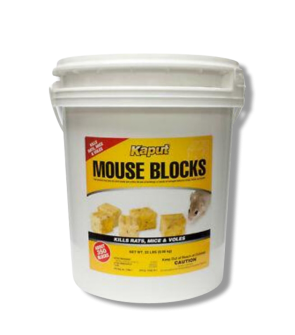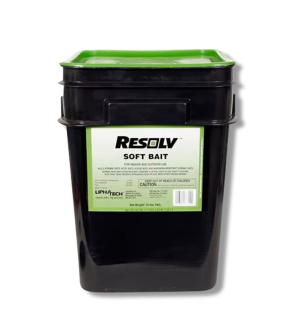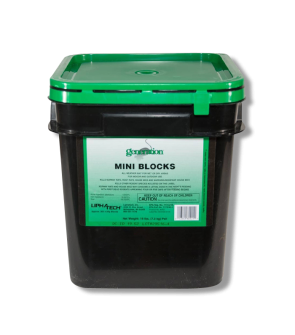Gain access to personalized product screening, the best pricing, rewards, and more!
Most Effective Products
Rodenticides
This page is an expert guide on getting rid of rats and mice from your home by poisoning them with rodenticide baits. Follow this guide and use the recommended products. We guarantee you will be successful in controlling rat and mice populations by learning more about rodenticide baits and the pest itself.
No homeowner wants rats or mice in their house or yard, which is why some look into rodenticides. Rodenticides, otherwise known as rat or mouse poison, are an easy and effective method of rat and mouse control when used as directed per the product label instructions. However, with so many variations of rodenticides, it can seem overwhelming and confusing when trying to choose one for your needs.
This DIY guide will provide extensive information about rodenticides, why and when you should use them, and how to safely use them to control rat and mice infestations around your home.
What Are Rodenticides?
Rodenticides are pesticides used for killing rodents such as rats or mice. Depending on the manufacturer, rodenticides can be referred to as rat poison or mouse poison.
What Are the Different Types of Rodenticides
Rodenticides can be divided into three categories: baits (which come in blocks, pellets, granules, liquids, gels, treated grains, and soft (pouches)), tracking powders, and fumigants. Both baits and tracking powders are the most commonly used rodent poisons. These products must be eaten by rodents to be effective.
Baits such as Warfare Rodent Bait are designed to attract rodents to a bait station. Based on the bait, it can be used either outdoors or in and around a structure.
Tracking powders are placed where rodents are most often traveling or likely to get them stuck to their fur or feet, which then kills the pest during grooming activities.
Fumigants are toxic gases designed to kill rats and mice in their burrows or tunnels.
Rodent Bait Classes
Each type of rodenticide works in different ways, so it is important to know what exactly the rodenticide is classified as. Knowing what type of rodenticide formulation it is will also help determine how long it may take to see rodent populations decrease and other effects it may produce.
There are many different rodenticides, but they are usually classified as anticoagulants or non-anticoagulants. Anticoagulants function by interfering with the rat or mouse blood clotting capabilities.
First Generation Anticoagulant Rodenticides (FGAR): require rats and mice to consume the bait over multiple feedings to deliver a lethal dose. These act as blood thinners, so rodents can consume a lethal amount without dying by internal bleeding until later. They are used to help prevent rats and mice from becoming shy to the product allowing a majority of the infestation to eat the bait then perish.
Second Generation Anticoagulant Rodenticides (SGAR): SGAR is similar to FGAR in that it also prevents blood from clotting, leading to internal bleeding in rodents. SGAR, however, has a higher concentration of active ingredients and is, therefore, more lethal in one single feeding. Typically, SGARs are used when rats or mice have become resistant to first-generation anticoagulants (FGAR). While SGARs are more powerful, the more potent product concentration means the poison is more likely to stay active in a dead rodent, risking exposure to scavenging wildlife or pets.
Non-Anticoagulant Rodenticides (NAR): unlike FGAR and SGAR, this type of rodenticide functions by targeting different organs in the rodent through one or multiple doses. The issue with NAR is that the reliability is heavily dependent on pre-baiting processes and the percentage of chemicals.
How to Use Rodenticides Safely
When rodenticides are used carefully and in accordance with their product label instructions, they are safe. The active ingredients in most rodenticides are toxic to rats and mice and may be dangerous to other animals if they are not used correctly.
Before starting any treatment, wear the proper personal protective equipment (PPE). We recommend wearing gloves to keep your human scent off any products.
- Always read and follow the product label instructions. When used according to the instructions and placed within a tamper-proof bait station, they pose little risk.
- With a glove-covered hand, remove any dead rats and mice you find, then properly dispose of them.
- Always wear the proper personal protective equipment (PPE) when handling or applying any type of rodenticide material.
- For most rat or mouse infestations, we recommend you use a First Generation rodenticide to eliminate your rodents with the least risk of secondary poisoning to other animals. Check out Warfare Rodent Bait, which is a synthetic bait made with 0.025% wafarin and rodent attractants. We recommend you use this bait with the Solutions Rat and Mouse Bait Station.
How Does Rat Poison Work
Rodenticide products mainly thin rodent blood, leading to internal bleeding, through various active ingredients. As a homeowner or professional, it is important you read your product's label and note its active ingredient and concentration. This way, you can keep track of what products work for you and which ones do not.
When one rodenticide product doesn't work, you can try a different one with a higher concentration or a different active ingredient.
Common active ingredients found in first-generation anticoagulant rodenticides are warfarin, chlorophacinone, or diphacinone. Second-generation anticoagulant rodenticides mainly consist of the active ingredients brodifacoum, bromodialone, difenacoum, or difethialone. Non-anticoagulant rodenticides use the active ingredients bromethalin, cholecalciferol, zinc phosphide, or strychnine.
Warfarin: is an anticoagulant, often called blood thinner, that decreases Vitamin K levels in the target pests blood. The decrease prevents blood from clotting leading to eventual internal bleeding. It causes this action within 24 hours of contact, but changes in the pests body can take between 3 to 5 days.
Chlorophacinone: is a multiple feed anticoagulant rodenticide that also decreases Vitamin K levels in the target pests blood, with the exception that chlorophacinone is chemically different by falling under the indane-class. Symptoms of this chemical does not appear right away, and may take between 3 to 10 days for rodents to die.
Diphacinone: is an anticoagulant rodenticide that works to stop Vitamin K levels, which causes internal bleeding within the target pest. Like chlorophacinone, this chemical is in the indane class. However, diphacinone is more toxic than warfarin and has a slightly higher active life. Once pests consume this material, it takes between 3 and 10 days for them to perish.
Brodifacoum: is a long-acting 4-hydroxycoumarin anticoagulant that prevents the clotting of blood leading to internal bleeding and eventual death of target pest. A single feeding of this chemical can cause symptoms in rodents within 4 to 8 days.
Bromodialone: is a strong and long-acting 4-hydroxycoumarin anticoagulant. It is very potent, and once ingested by target pests it stops the pest blood from clotting, causing death within 24 hours.
Difenacoum: is a single-feed anticoagulant rodenticide belonging to the 4-hydroxycoumarin. Once ingested, it inhibits the Vitamin K levels in the pests blood causing internal bleeding in 2 to 3 days.
Difethialone: is a single-feed anticoagulant rodenticide derived from 4-hydroxybenzothiopyranone. One the pest ingests this material it begin to exhibit signs within 2 to 3 days, but might be as instant as 24 hours. When consumed, this chemical causes the pest to suffer from respiratory distress or liver damage leading to death.
Bromethalin: is a neurotoxin that damages the pests' central nervous system. Depending on the percentage it can cause vomiting, seizures, paralysis, and then death for the pests in 24 to 36 hours.
Cholecalciferol: is a sterol of vitamin D that causes high levels of blood calcium and phosphorus, resulting in kidney failure, internal bleeding, and eventual death. Results from this single feed bait may not show in pests until 3 to 7 days.
Zinc Phosphide: is an inorganic rodenticide. When ingested it reacts with water and stomach juices of pest to release phosphine gas, causing stomach pain, vomiting, low blood pressure, central nervous system damage, and collapse of livers, lungs, kidney, and heart leading to death. Death for pest occurs within 15 minutes to 4 hours.
Strychnine: is a highly toxic natural substance that causes violent muscular convulsions because of its ability to be readily absorbed into the central nervous system. These convulsions occur within 15 to 20 minutes of ingestion, followed by death with impaired breathing.
Benefits of Rodenticides
When used properly, rodenticides efficiently reduce rodent populations, particularly rats and mice. These pests pose significant threats to public health health, agriculture, and infrastructure.
By eliminating rodent populations, you can prevent infestations that lead to property damage and food contamination. Not to mention, rodents are carriers of harmful diseases like the plague, salmonellosis, and more, thus minimizing the spread of these diseases to people and animals.
Rodents also like to gnaw on electrical wiring, insulation, and plumbing, increasing the risk of fires and safety. Effective rodent control prevents such damage.
Compared to other control methods, rodenticides provide a long-lasting and affordable approach to rodent management, especially in large areas.
While rodenticides offer numerous benefits, they must be used responsibly to prevent harm to non-target species and the environment. Proper handling and placement ensure effective and safe rodent control.
Drawbacks of Rodenticides
Rodenticides, while effective in controlling rodent populations, come with several significant drawbacks.
One major concern is non-target poisoning, where pets, livestock, and wildlife may accidentally consume poisoned baits or prey on rodents that have ingested the toxins, leading to serious health risks or death. Birds of prey, such as owls and hawks, are especially vulnerable to secondary poisoning, which disrupts natural ecosystems.
Human health risks are also a concern, particularly for children who may accidentally ingest rodenticide baits, leading to toxic effects such as internal bleeding, neurological damage, or organ failure. Another drawback is rodent resistance, where overuse of certain rodenticides leads to rodents developing immunity, making control efforts less effective and necessitating stronger or alternative poisons.
Furthermore, many rodenticides act slowly, allowing rodents to die in hard-to-reach areas, causing unpleasant odors and requiring extensive cleanup.
To mitigate these issues, rodenticides should be used responsibly, following safety guidelines and integrating alternative pest management strategies for a more sustainable approach.
How to Poison Rats and Mice with Rodenticide Bait
Before applying any type of rodenticide, make sure to wear the proper personal protective equipment (PPE), such as gloves. Rodents are very cautious creatures, and they will avoid any product you handle if they smell your scent.
We recommend using a first-generation rodenticide to control your rat and mouse population, as the multi-feed effect allows the product to spread to multiple pests.
Warfare Rodent Bait is a synthetic rodenticide that falls under the first-generation rodenticide, meaning it will control rats and mice in several days through multiple feedings. Like most rodent baits, it will need to be placed in a tamper-proof bait station such as the Solutions Rat and Mouse Bait Station.
Step 1: Bait

While wearing gloves, place 4 to 6 Warfare Rodent Bait Blocks on the metal rods inside the Solutions Rat and Mouse Bait Station. Once you have applied the appropriate bait blocks, lock the station with the included key.
Step 2: Place and Monitor Bait Station

Rats are more cautious than mice because they cannot hide as easily as mice due to their large size. For this reason, rats are less prone to traveling in open, spaced areas, preferring to run alongside walls.
Multiple bait stations should be used as rats and mice can avoid certain areas for a period of time, and this will help solve infestations more quickly with increased bait availability. Solutions Rat and Mouse Bait Stations should have a 20 to 40-foot distance between each station used.
Once a day, check inside the bait station to replace Warfare Rodent Bait and any deceased rodents. Continue to use these products until rat and mouse activity is no longer noticed.
What to Expect with Rodenticides
When using rodenticides, expect effective rodent control and potential risks. Rodents may take hours or days to die, sometimes in hidden areas, leading to odor issues.
Secondary poisoning can affect pets, wildlife, and non-target animals. Some rodents may develop resistance, reducing effectiveness over time. Human health risks exist, especially for children and pets, if ingested.
Proper placement, secure bait stations, and following safety guidelines are essential. For best results, combine rodenticides with other pest control methods like sanitation and exclusion to prevent reinfestation and ensure long-term effectiveness.
Key Takeaways
Why are Rats and Mice Dangerous?
- Rats and mice can spread diseases when they travel through plumbing and urinate and defecate across various surfaces in and around your home. They can also carry lice, fleas, mites, ticks, and other pests in their fur and skin. If you have a garden or machinery in your yard, burrowing into soil/walls and gnawing on electrical wiring can cause fires and other costly repairs.
Why Use Rodenticides
- Anticoagulant rodenticides allow homeowners to kill pests without direct contact by using certain chemicals through one or multiple feedings. When products like Warfare Rodent Bait are ingested, the entire rat and mouse infestation visits and consumes the bait for complete elimination.
Alternatives to Rodenticide Baits
- Other non-toxic methods to control rats and mice are to use glue traps, mouse snap traps, rat snap traps, repellents, or humane traps. However, it is best to use multiple forms of control as one product is not guaranteed for complete rodent elimination. Solutions Pro Glue Board is a non-lethal glue trap with a peanut butter scent that draws pests like mice. Snap traps are best used indoors and cause pests to be immediately killed when the product is activated. We recommend using Solutions Easy Set Mouse Trap for mice and Solutions Easy Set Rat Trap for rats, as both of these products have an easy-release feature that prevents contact with pests and bars. For a non-lethal approach, you may use a humane trap like the Multi-Catch Humane Mouse Trap, which captures and holds up to 30 mice per use.







